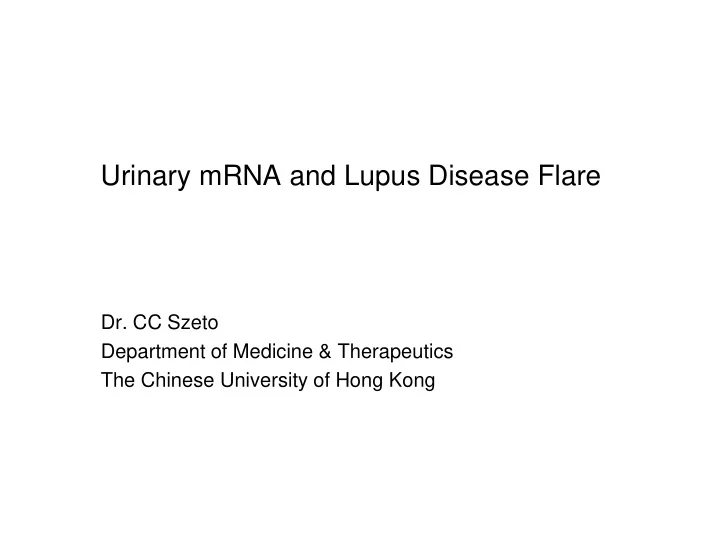

Urinary mRNA and Lupus Disease Flare Dr. CC Szeto Department of Medicine & Therapeutics The Chinese University of Hong Kong
Hypothetical model autoantigens lack of T cell extrinsic regulation trigger auto-reactive T cells recruitment of bystander T B cells lymphocyte and other produce mononuclear cells autoantibody susceptible patients immune renal inflammation, complex cell proliferation deposite in and fibrosis kidney
Lymphocyte subsets
Th1 / Th2 imbalance • 100 patients and 10 controls Conclusions: Patients with active lupus nephritis have increased T-bet and depressed GATA-3 expression in urinary sediment and kidney, indicating a predominant Th1 lymphocyte activation. Chan RW, et al. Rheumatol 2006; 45; 91-957.
Does it predict subsequent flare? 1.0 Proportion of Patients without Lupus Flare 0.8 0.6 0.4 0.2 High T-bet / GATA-3 ratio Low T-bet / GATA-3 ratio 0.0 0 12 24 36 48 Weeks Conclusions: Patients with clinically quiescent lupus but increased T-bet to GATA-3 expression ratio in urinary sediment have a higher chance of disease flare, probably because of underlying Th1 lymphocyte activation. Chan RW, et al. Rheumatol 2006; 45; 91-957.
Validation study • 60 quiescent SLE patients • urinary mRNA expression of T-bet and GATA-3 quantified by the RT-QPCR • patients were followed for 4 years for disease flare
T-bet level is important (A) (B) 1.0 1.0 low T-bet 0.8 0.8 low T-bet survival free of major flare survival free of any flare 0.6 0.6 0.4 0.4 high T-bet 0.2 0.2 high T-bet log rank test, p = 0.001 log rank test, p = 0.001 0.0 0.0 0 12 24 36 48 0 12 24 36 48 follow up (months) follow up (months) Chan RW, et al. Rheumatol 2007; 46: 44-48.
Cut-off value (A) (B) 1.0 1.0 0.8 0.8 T-bet expression 0.6 0.6 Sensitivity Sensitivity = 3-fold normal T-bet expression = 3-fold normal 0.4 0.4 0.2 0.2 AUC = 0.735 AUC = 0.790 0.0 0.0 0.0 0.2 0.4 0.6 0.8 1.0 0.0 0.2 0.4 0.6 0.8 1.0 1 - Specificity 1 - Specificity Chan RW, et al. Rheumatol 2007; 46: 44-48.
Conclusion of this part • high urinary T-bet mRNA level was an independent predictor of lupus flare • possibilities – short term immune system (Th1) activity ? – baseline tendency of Th1 activation ?
Other lymphocyte subsets • 78 patients with SLE nephritis with various disease activity • urinary mRNA levels of Th17-related cytokines Kwan BC, et al. Rheumatol 2009; 48: 1491-1497.
Regulatory T cells • 2 studies with 98 patients with active lupus nephritis Wang G, et al. Rheumatol 2009; 48: 755-760. Luk CC, et al. J Rheumatol 2015; 42: 1150-1155.
Is monitoring of urinary mRNA useful? • cohort of 134 adult SLE patients • prospectively followed for 56 weeks • identified 19 patients with a single disease flare • compared to 19 matched controls with no disease flare during the same period • mRNA levels of eight pre-defined target genes in their urinary sediment before disease flare were measured
Change in serological markers Szeto CC, et al. Clinica Chimica Acta 2012; 413: 448-455.
Change in inflammatory cytokine mRNA Szeto CC, et al. Clinica Chimica Acta 2012; 413: 448-455.
Change in Th transcription factor mRNA Szeto CC, et al. Clinica Chimica Acta 2012; 413: 448-455.
Major vs minor flares Szeto CC, et al. Clinica Chimica Acta 2012; 413: 448-455.
Severity of flare and change in urinary mRNA Szeto CC, et al. Clinica Chimica Acta 2012; 413: 448-455.
Summary • baseline urinary T-bet mRNA level in quiescent SLE patient is an independent risk factor of subsequent flare • serial monitoring of MCP-1, IL-17, GATA-3 and FOXP3 mRNA level in urinary sediment may provide an early clue for detecting disease flare
Further research questions • predictive accuracy and cost-effectiveness when added on to current serological monitoring • optimal frequency of monitoring • role of pre-emptive treatment • prediction of refractory disease
Acknowledgement • Nephrology: Bonnie Kwan, KM Chow, CB Leung • Rheumatology: LS Tam, Edmund Li • Pathology: Fernand Lai, Paul Choi • Laboratory: Rebecca Chan, G Wang, KB Lai, Cathy Luk • Nursing: Lee Wai Ching, Lau Miu Fong • These studies were supported in part by the Hong Kong Society of Nephrology Research Grant and the Chinese University of Hong Kong (CUHK) research account 6901031.
Recommend
More recommend